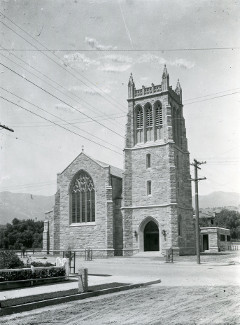The Craft of Stone Masonry in Santa Barbara
Churches, Bridges, Gates, and Walls Reveal the Masons' Skill

Stone has been a time-honored building material in Santa Barbara since the earliest days of the city. Wood was never in great supply. Although the region was dotted with thousands of oak trees, their twisted trunks and branches did not make for useable lumber. Early settlers turned to other building materials during the Spanish and Mexican eras — adobe primarily, but also stone. Stone, especially sandstone, was readily at hand in the creek beds and canyons.
The outstanding example of stone craft dating from the Spanish period is the Santa Barbara Mission. Under the tutelage of the padres, Chumash neophyte laborers cut stone taken from the Mission Creek area for the mission proper, as well as for the extensive water system, including an aqueduct network and the dam that still stands on Mission Creek in the Santa Barbara Botanic Garden.
The “golden age” of local stone masonry began in the 1870s with the arrival of a number of artisans from the British Isles. Most of these worked in the classic British style of cutting rectangular stones and laying them in parallel, often offset rows. In the last decades of the 19th century, these British transplants filled Santa Barbara with magnificent stone buildings. These included the Unitarian Church at the corner of State Street and Arlington Avenue. Completed in 1890, it was the masterpiece of Thomas Hogan. Unfortunately, it was destroyed in the 1925 earthquake. The stone Trinity Episcopal Church, the work of Peter Poole, did survive the earthquake, although not without heavy damage. Other classic statements of the Anglo masons’ art include the entrance gates to Junipero Plaza, the 1,200-foot wall that runs along the property of the Santa Barbara Cemetery, and the superb bridge over Rattlesnake Creek.
One of the most important stonemasons of British descent was Joseph Dover, the son of an English seaman. A walk along Puesta del Sol Road in Mission Canyon will afford one the opportunity to admire the sawtooth wall built by Dover in the 1890s. He always considered it his finest work. The stone bridge over Mission Creek is another example of Dover’s craft.
A second wave of artisans, from Italy, began to arrive in this area around the turn of the century. Many of these stonemasons worked in a less symmetrical style than their British counterparts. Much of their work may be viewed along the twisting roads of Santa Barbara’s Riviera and in Montecito. The Clarence Black estate was one of the first residences in the Riviera area to have extensive stonework. George Batchelder, the primary early developer of the Riviera, hired a number of Italian masons to construct walls along the hillside roads. A number of estates in Montecito also boast magnificent stonework. One of the most outstanding examples is the former Stanley McCormick estate, Riven Rock. Reportedly, some 40 masons labored 20 years to create the walls, bridges, and other creations that grace the property.
The use of power tools has somewhat altered the face of the industry, but what has not changed is the pride in craftsmanship that is evident in the creations of today’s masons. Stonework remains one of the outstanding features of Santa Barbara’s urban landscape.
Michael Redmon, director of research at the Santa Barbara Historical Museum, will answer your questions about Santa Barbara’s history. Write him c/o The Santa Barbara Independent, 12 East Figueroa Street, Santa Barbara, CA 93101.



